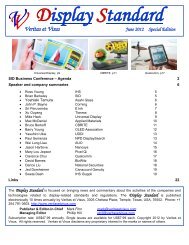You also want an ePaper? Increase the reach of your titles
YUMPU automatically turns print PDFs into web optimized ePapers that Google loves.
<strong>Veritas</strong> <strong>et</strong> <strong>Visus</strong> <strong>Display</strong> <strong>Standard</strong> February 2009<br />
Dell previews G-Series LED monitors that deliver energy efficiency<br />
Dell announced its G-Series of LED wide-screen flat panel monitors with the introduction of the G2210 22-inch<br />
and G2410 24-inch models. G-Series high-performance EPEAT Gold and ENERGY STAR-compliant monitors are<br />
distinguished by a design approach that combines energy efficiency, LED technology, recycled materials and other<br />
environmentally preferable components. Availability of the G2210 and G2410 monitors through Dell.com is<br />
planned for late February, with prices starting at $279 and $359 respectively. http://www.dell.com<br />
Greenpeace releases green electronics report<br />
The greenest consumer electronic products on the mark<strong>et</strong> today have a smaller environmental footprint than those<br />
sold a year ago but the industry as a whole still has plenty of room for improvement, according to a new survey<br />
released by Greenpeace. “Green Electronics: the search continues” assesses the progress made over the past year by<br />
consumer electronics companies on their public commitments to green their products. Fifteen major electronics<br />
brands submitted 50 of their most environmentally friendly new products – mobile and smart phones, televisions,<br />
computer monitors, notebook and desktop computers, and game consoles. Greenpeace assessed and scored each of<br />
these products against a s<strong>et</strong> of environmental criteria.<br />
Greenpeace found that fewer electronic products on the mark<strong>et</strong> contain harmful PVC plastic and fewer hazardous<br />
chemicals are being used in products. LED displays, which save energy and avoid the use of mercury in backlights,<br />
are more commonplace. Manufacturers are using larger quantities of post-consumer recycled plastic in TVs and<br />
monitors and producers have established more comprehensive voluntary take-back and recycling programs. Most<br />
companies have also adapted quickly to the new requirements of Energy Star.<br />
The Lenovo L2440x wide computer monitor scored highest with 6.9 points (on a 10-point scale) and is far ahead of<br />
the comp<strong>et</strong>ition in the monitor category. Other product category leaders include the Sharp LC-52GX5 television<br />
(5.92), the Samsung F268 mobile phone (5.45), the Nokia 6210 Smart phone (5.2) the HP Elitebook 2530P laptop<br />
(5.48) and the Lenovo ThinkCentre M58 desktop (5.88). The Greenpeace report is available at<br />
http://www.greenpeace.org. Companies that chose to participate in the survey were: Acer, Dell, Fujitsu Siemens,<br />
Hewl<strong>et</strong>t Packard, Lenovo, LG Electronics, Motorola, Nokia, Panasonic, RIM/Blackberry, Sharp, Samsung, Sony,<br />
Sony Ericsson and Toshiba. The companies that refused to take part in the survey were: Apple, Asus, Microsoft,<br />
Nintendo, Palm, and Philips. Only Sony submitted game consoles for review.<br />
Samsung develops LED that eliminates “droop”<br />
A new breakthrough by researchers with Rensselaer Polytechnic Institute’s National Science Foundation-funded<br />
Smart Lighting Engineering Research Center and Samsung Electro-Mechanics may bring LED lighting closer to<br />
affordability and help the researchers creep closer to<br />
The figure<br />
highlights “LED<br />
droop”, which<br />
decreases LED<br />
lighting<br />
efficiency and<br />
brightness. The<br />
Rensselaer<br />
Polytechnic<br />
Institute and<br />
Samsung have<br />
come up with a<br />
new LED.<br />
82<br />
a DOE-funded $20M prize. The new type of LED is<br />
said to be “polarization matched” and gives 18%<br />
increase in light output and a 22% increase in wallplug<br />
efficiency. The droop phenomenon involves<br />
LEDs being most efficient when operating on low<br />
current densities, and seeing their efficiency greatly<br />
droop at higher current densities. While all the<br />
factors have y<strong>et</strong> to be d<strong>et</strong>ermined, electron leakage is<br />
one source of droop. The end result of droop is that<br />
LEDs are forced to operate at lower current<br />
densities, which feature much lower brightness and<br />
efficiency in achieving light output. The new<br />
research is reported in Applied Physics L<strong>et</strong>ters.






